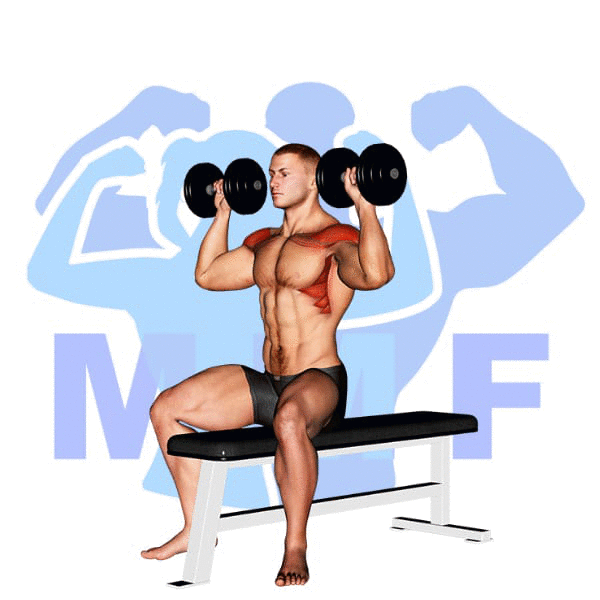The Seated Dumbbell Shoulder Press develops your entire shoulder muscle group. Additionally, dumbbells allow for greater freedom of movement than the Barbell Shoulder Press. Consequently, the greater freedom of movement increases your shoulder muscle activation. and can also be very useful for people with shoulder injuries since the dumbells are far less stressful to the shoulder joint.
Seated Dumbbell Shoulder Press – A Basic Compound Movement
Like the standing version, the Seated Dumbbell Shoulder Presse is an essential compound exercise (involves two or more joint movements) that require muscles on both sides of the shoulder joint to fire, but they primarily recruit the anterior (front) deltoids.
- Primary Muscles Worked: Deltoids
- Other Muscles (Secondary) Worked: Supraspinatus, Triceps, Trapezius, Serratus Anterior
- Equipment: Dumbbells, Bench, Seat
- Mechanics Type: Compound
- Force: Push
- Utility: Basic
Seated Dumbbell Shoulder Press Form
The Seated Dumbbell Shoulder Press should be performed with a backrest. For example, you can use an adjustable incline bench set to just under 90 degrees or you can use the seat of a preacher bench. For this reason, when using a preacher bench you will have your back against the pad, so you will be facing the opposite way. Specifically, you want the pad slightly above the small of your back.
- Start by holding each dumbbell in a hand at your shoulder height using a pronated grip. You want your elbows pointed downward and to the sides. In this ready position, inhale before you press.
- Now, while exhaling drive both dumbbells overhead in a slight arc until your elbows are fully extended. You don’t need to look up and shouldn’t look down. A good practice is to keep the head upright and in a neutral position. It is best if there is a mirror in front of you, then you can monitor and correct your form.
- Be careful not to clang the dumbbells together. Additionally, do not lock your elbows out (this will keep tension on the deltoids).
- Finally, slowly lower the dumbbells to the starting position, and remember to inhale on the way down.
- Repeat.

Target Muscles Developed
Primary (Agonist) Muscles
- Deltoid, Lateral
Synergist Muscles
- Supraspinatus
- Triceps Brachii
- Trapezius, Middle
- Trapezius, Lower
- Serratus Anterior
- Inferior Digitations
- Pectoralis Major, Clavicular
Dynamic Stabilizers Muscles
- Triceps, Long Head
- Biceps Brachii
Stabilizers Muscles
- Trapezius, Upper
- Levator Scapulae
Tips to Improve Your Results
- Keep the weight directly above your elbows by ensuring your forearms are vertical.
- Ensure your wrists are in a neutral position, do this be having your pinkies slightly higher than your thumbs during the movement. To do this, you will be tipping the dumbbells slightly down and in towards your center. To visualize if the dumbbells were water bottles, you would be pouring the water on your head. When you tip the dumbbells inward, you are increasing the tension in the deltoids.
Common Errors to Avoid
The following errors are potentially dangerous and can result in injury. Avoid them at all costs.
- Leaning back. When your shoulders and arms start to fatigue, you may tend to lean back. By leaning back you are turning the exercise into an incline press with no back support. You will reduce the effectiveness of the training your shoulders, as well as placing an unnecessary strain on the lower back.
- Not wearing a lifting belt. Remember, lower back issues are not cool, which means lifting belts are cool. Not wearing a belt will place an unnecessary strain on your lower back, especially as you increase the weight.
Possible Injuries
The incorrect form may lead to multiple types of injuries including:
- Torn ligaments/tendons in shoulders.
- Back injuries.
Seated Dumbbell Shoulder Press Variations
The seated dumbbell shoulder press has several variations. Variation exercises are exercises intended to work different subgroups of muscles or work the same muscles in slightly different ways.
All of these shoulder exercises can be performed either seated or standing. With seated shoulder press exercises you will be able to handle more weight if you lean back against a pad. With a standing or seated unsupported shoulder press, you’ll need more muscles for stabilization, and the extra work will demand lighter weights. Try these variations of the dumbbell overhead press.
- Alternating Dumbbell Shoulder Press – Set up like a bilateral, except that you raise and lower one dumbbell, then the other.
- Single Dumbbell Shoulder Press – Do all of your reps on one arm, then the other.
- Top Hold Alternating Dumbbell Shoulder Press – Extend both dumbbells overhead. Now, hold one there while you bring one down and then back up. Hold that dumbbell overhead while you bring the other down and then up.





